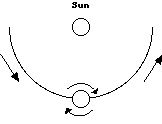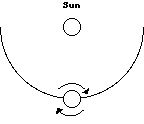In a single sentence, describe where in the sky the North Celestial Pole (NCP) would be as viewed from a latitude of 10° north of the Earth’s equator. Draw the relative locations of the Earth, the NCP (currently marked by Polaris) and your horizon at a latitude of 10° North to support your answer. Diagram and sentence required for full credit.
--
In a single sentence, describe where in the sky the South Celestial Pole (SCP) would be as viewed from a latitude of 10° south of the Earth’s equator. Draw the relative locations of the Earth, the SCP and your horizon at a latitude of 10° South to support your answer. Diagram and sentence required for full credit.
--
Suppose you are kidnapped and taken to some unknown remote location on the Earth. You wake up and look outside, and it is a clear night. In the Northern sky, you notice the constellations of the Zodiac, which are found near the Celestial Equator. You estimate from your observations that the Celestial Equator is at an angle of about 25 degrees above your Northern horizon. At what latitude on Earth are you located? Explain your answer (a diagram may help but is not required).
--
Suppose you are kidnapped and taken to some unknown remote location on the Earth. You wake up and look outside, and it is a clear night. In the Southern sky, you notice the constellations of the Zodiac, which are found near the Celestial Equator. You estimate from your observations that the Celestial Equator is at an angle of about 65 degrees above your Southern horizon. At what latitude on Earth are you located? Explain your answer (a diagram may help but is not required).
--
Describe a situation in which you might use Right Ascension and Declination to provide the location of a constellation, then do the same for a situation in which you might use altitude and azimuth. Briefly state a benefit and a drawback of each of the two types of coordinate systems.
--
Draw a celestial sphere. Label the north and south celestial poles, the celestial equator, and then draw in the daily motion of a star at high declination and low declination. Use this diagram to help explain why high declination stars are more likely to be circumpolar compared to low declination stars.
--
Use a simple diagram to help explain why the constellation Cygnus will be near the horizon at sunset tonight and then nearly overhead by midnight.
--
Explain why certain seasonal constellations, like Orion, are only visible in the night time sky at certain times of the year. Also, why is the Little Dipper visible at all times during the year?
--
Explain why early Astronomers felt that the motion of the stars could best be explained by a rotating heavenly celestial sphere of stars we observe from a motionless Earth, instead of the model we know to be true today.
--
Use a simple diagram to help explain why the altitude of the North Celestial Pole above your Northern horizon is equal to your Northern latitude. One way to do this is to show a couple of cases (high and low latitude) as examples to help prove your case.
--
In the Copernican (heliocentric) model of the solar system, it is very easy to explain why we see different constellations overhead at midnight at different times of the year. But the Copernican system was not always accepted by Astronomers.
a) (6 pts) Explain why we see different constellations overhead at midnight in June as opposed to September.
b) (8 pts) One reason the heliocentric model wasn't accepted was that Astronomers did not observe parallax shifts for any stars in the sky. Explain how these observations were used as evidence against the "heliocentric hypothesis" (abbreviate as HH if you like).
--
The apparent lack of stellar parallax was a problem that greatly obstructed the acceptance of Copernicus' heliocentric model by the scientific community.
a) (7 pts) Why did the geocentric model predict there would be no parallax angles for stars?
b) (7 pts) Explain how the Copernican model could be considered consistent with reality provided stellar distances are incredibly high.
--
For reference, the length of the sidereal day is 23 hours and 56 minutes. The length of the solar day is 24 hours. But what if we changed things a bit...
Suppose the Earth were no longer orbiting the Sun but instead remained stationary at its current distance of 93 million miles away from the Sun. Assume the rotation period of the Earth is unchanged from its present value for this hypothetical.
a) (4 pts) What would the length of the sidereal day be in this case? Explain.
b) (4 pts) What would the length of the solar day be in this case? Explain.
--
Explain why the sidereal day is and why it is shorter than the solar day. A diagram may help your answer.
--
The constellation Cygnus appears in a certain place in our sky at around 10pm local time.
a) (8 pts) Draw a simple star chart of Cygnus, then name one of the brightest stars and indicate the altitude and azimuth at which Cygnus can be found at about 10pm tonight.
b) (6 pts) Baghdad, Iraq has almost exactly the same latitude as Fort Worth. Would Cygnus appear in roughly the same place in the sky at the same local time as in part a, or would it be east or west of that location? Explain your answer.
--
For Ursa Major and Cepheus, provide the following information:
- Approximate altitude and azimuth at 10pm this evening.
- Name of one of the bright stars in each constellation.
- Sketch of the star chart for each constellation.
--
For the constellations Ursa Major and Hercules, please provide the following information:
- Star chart (with lines connecting stars to show shapes)
- Approximate altitude and azimuth in tonight’s sky
- Name of the two brightest stars.
--
While some constellations, like Orion or Cygnus, are only visible in the evening at certain times of the year, other constellations like Cassiopeia and Ursa Minor, are visible every evening from northern latitudes.
a) (4 pts) Explain why we see different constellations overhead at the same time of night on different days of the year. A diagram would definitely help, but you also need an explanation as part of your answer.
b) (4 pts) Explain why circumpolar stars are only found at high celestial latitudes. Again, a diagram may help, but you also need to explain.
--
One of the interesting things about the planet Venus is that it rotates in a retrograde direction (clockwise as seen from above). In other words, it rotates in a direction opposite to its orbital direction (counter-clockwise as seen from above), as shown in the diagram below. Assume for simplicity that Venus has a rotation period of 24 hours.
The sidereal day on Venus measures how long it takes for a distant star to return to the same location on the sky. The solar day measures how long it takes for the Sun to return to the same location on the sky.
a) (2 pts) Which is longer on Venus? (sidereal day, solar day, same length).
b) (6 pts) Explain your answer to part (a).

--
Suppose the Earth's rotation were the same speed but opposite direction as it is now (one clockwise rotation every 23h 56m) but the Earth's orbital velocity drops to zero, so that the Earth is not orbiting the Sun at all but simply stationary as shown below.
a) (4 pts) Would the sidereal day be longer, shorter or the same length as the solar day? Explain your answer.

b) (4 pts) In which direction would the Earth have to orbit the Sun in order for the sidereal day to be shorter than the solar day (or does it matter)? Explain (simple diagram may help).